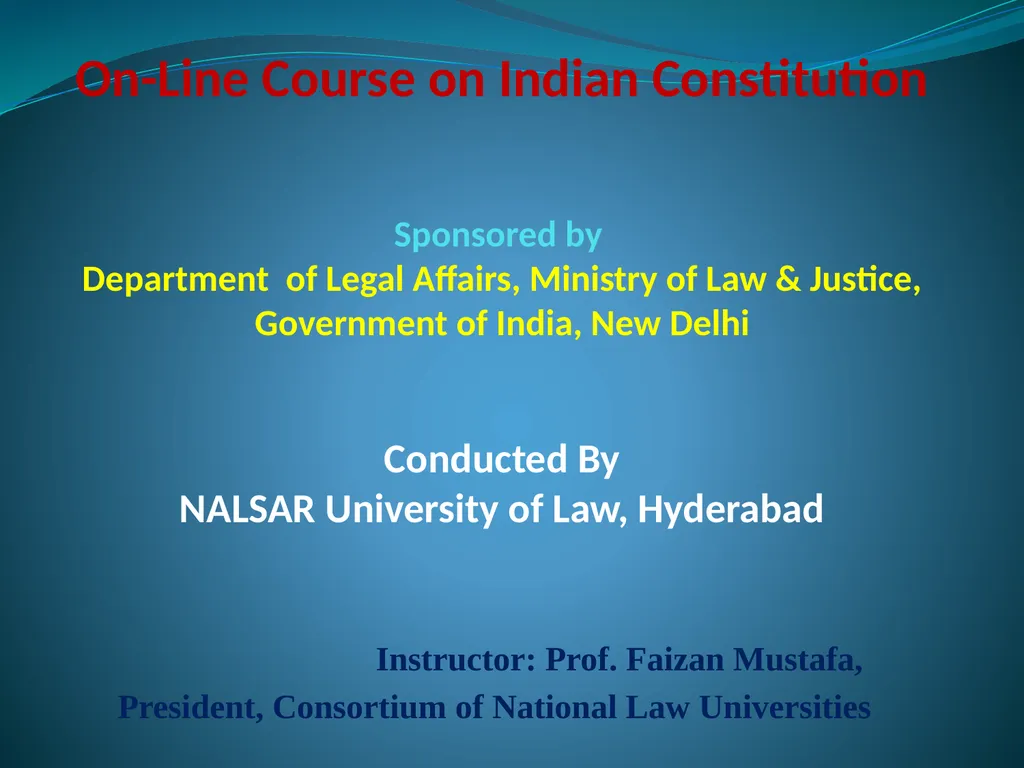On-Line Course on Indian Constitution Sponsored by
Author : debby-jeon | Published Date : 2025-05-10
Description: OnLine Course on Indian Constitution Sponsored by Department of Legal Affairs Ministry of Law Justice Government of India New Delhi Conducted By NALSAR University of Law Hyderabad Instructor Prof Faizan Mustafa President
Presentation Embed Code
Download Presentation
Download
Presentation The PPT/PDF document
"On-Line Course on Indian Constitution Sponsored by" is the property of its rightful owner.
Permission is granted to download and print the materials on this website for personal, non-commercial use only,
and to display it on your personal computer provided you do not modify the materials and that you retain all
copyright notices contained in the materials. By downloading content from our website, you accept the terms of
this agreement.
Transcript:On-Line Course on Indian Constitution Sponsored by:
On-Line Course on Indian Constitution Sponsored by Department of Legal Affairs, Ministry of Law & Justice, Government of India, New Delhi Conducted By NALSAR University of Law, Hyderabad Instructor: Prof. Faizan Mustafa, President, Consortium of National Law Universities Insert original logo of constitution Insert government of India and NALSAR logo on each slide It will make us better citizens & Help in Understanding our Constitutional Journey Constitution is Supreme Law of the Country Constitution tells us about our Fundamental Rights Constitution describes powers of various organs of the Government & details of the Centre-State Relations To get familiarized with the text of the Constitution & Leading Judgments To better appreciate current constitutional developments Why we should do this course? Course Details Eligibility: Anyone who has passed Class X Duration of Course: Fifteen Lectures Fee: Rs.500/- Examination: Online test of 50 multiple choice questions. To pass the course and get NALSAR’s certificate at least 50% marks be secured. Language: English Why constitutions are drafted, when they are drafted, what they should contain, what are their types. Constituent Assembly Debates and Choices made by the framers of the Constitution Preamble- What it includes, how it is amended, how it is used. Citizenship (Articles 5 to 11) Right to Equality- Reasonable Classification Course Syllabus Continued.. Affirmative Action- Reservation- Need and how long should it continue? Why improvements are to be made? Freedom of Speech- Limits- Sedition, Blasphemy, Defamation, controlling online speech. Right to Life & Liberty- Aadhar, Privacy Freedom of Religion- Essentiality test- Prayers in Schools Rights of Minorities- Right to Culture, Mother Tongue & NEP Directive Principles- Non-Justifiable Relationship Between Fundamental Rights & Directive Principles Continued.. Union Executive- Prime Minister – President Relations - Ordinance Making Article 51-A- Fundamental Duties: Relationship Between Fundamental Duties & Fundamental Rights. Judiciary- appointment of judges- Is judicial review anti -democratic? Amending Powers – Need, Important Amendments Basic Structure – Distinction between the Constituent Power and ordinary legislative powers. First Lecture Constitution is the Supreme Law of any country It is the solemn contract between State and People It incorporates people’s aspirations about their society It tells us about our Fundamental Rights and how to use these rights It informs us about our Fundamental Duties It describes powers of various organs of the Government It gives details of the Centre-State Relations What is Constitution? To achieve Constitutionalism To limit the powers of the State To ensure that














